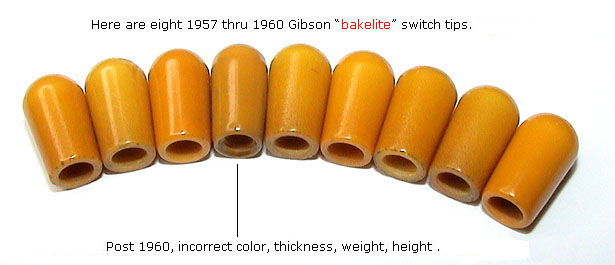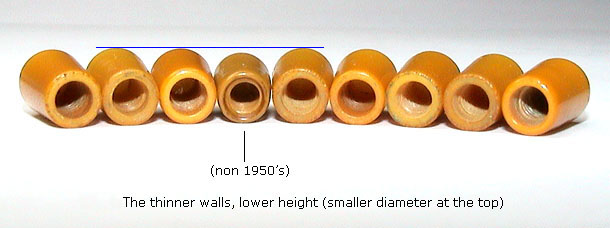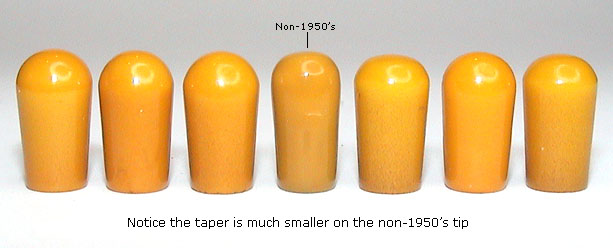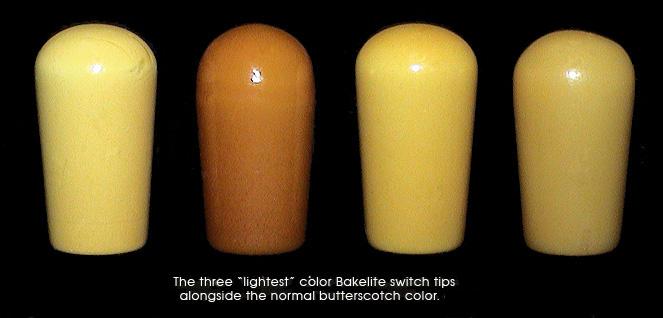Switchcraft Switch Tips 1947 to 1960 Info.
Gibson solidbody vintage guitars history and collecting. Private vintage guitar collector. Pictures, history for Gibson solidbody vintage guitars.
Picture Gallery, Gibson section.
Gibson General Info.
Contact the vintage guitar info guy.
Because of the amount of "bogus" switchcraft switch tips out there, I was asked to create this web page on Gibson switch tips. These original style of switch tips where used on Gibson vintage guitars from 1947 to 1960 (inclusive), and are made of Catalin (carbolic acid and formaldehyde). Often they are called Bakelite, but really they are Catalin (which is a less fiber version of Bakelite).
Catalin was a poured resin plastic developed by the Catalin plastic company. Bakelite came earlier, and was in granular form, molded under high pressure which becomes hard under intense pressure and heat. Bakelite could be added to almost any material, such as softwood, asbestos, or fiber, which was the "catalyst" and the Bakelite instantly make it more durable and hard. Bakelite was a key ingredient in most of the weapons used in the Second World War. It was also used as a electrical insulator. For this it proved to be very effective. So effective that it is still used as such today.
Catalin on the other hand, is a casting resin (or cast phenolic) which is poured as a hot syrupy liquid into a lead form or mold When Catalin was first used in the mid-thirties, it allowed for many products to be made with bright colors i.e reds, yellows, greens, blues and marblized combinations. Because it is a poured resin, the colors did not "burn out" because of the heat factor involved with Bakelite. That is why most true Bakelite products are usually only black or brown. I believe that the switch tips are in fact Catalin and started out more of an ivory white/soft yellow and discolor (became more yellow) over time, very much in the same way that the highly sought after 30's-40's Catalin radios (among other things) did. Problem with Catalin is that it darkens upon exposure to ultraviolet light. The longer it's exposed to the sun, the darker the coloring. The material hits an end point where the color is almost a dark orange. Over time, the darkness of the surface layer permeates all the way through the material (again in response to UV light). Depending upon the exposure, some Catalin pieces can be polished to remove the surface layer to reveal a lighter color, while others can not (but please don't polish your switch tips!)
The Gibson-used switch tips (as gotten from Switchcraft) are most certainly made of Catalin. By 1961 Catalin switch tips had been replaced by switch tips made of "Plaskon". This was a more modern type of plastic and didn't change color over time.
Other guitar makers during the 1950s used these switch tips too. They were a standard tip available from Switchcraft (the maker of the switches). Infact, Switchcraft most likely supplied the switch tip with their switches. So if a guitar company was buying Gibson-style Switchcraft pickup selector switches during the 1950s, it came with this Catalin switch tip. These switch tips have an unique color, feel, smell, and shape. There are people trying to reproduce them and pass the repros off as originals (at inflated prices). Here are some tips to figuring it out.
Pictures by BurstMeUp - wow did he take some good pics!




Note if there are *any* mold marks on the switch tip in any
exterior spot, the tip is not an original 1947 to 1960 Catalin switch tip.

Another tip is to determine if the plastic is really Catalin/Bakelite (Phenolic Resin). How Can I Tell if It's Real?
Method #1:
Some Bakelite/Catalin collectors recommend the 409 Test. Here's how to do it:
- Dip a cotton swab in 409 household cleaner and touch a small area of the piece, such as a back that won't be visible.
- If the piece is vintage Bakelite or Catalin, the accumulated patina will show up as a yellow stain on the cotton swab.
- Rinse the cleaner off the tested spot right away.
Method #2
Rub the Catalin/Bakelite with your finger
until it gets warm. Then you should smell a sulfer/formalehyde scent on the finger
if it's Catalin or Bakelite.
Method #3:
Some recommend placing the Catalin or Bakelite in hot water, then
remove and sniff. Warmed it smells like camphor.
Method #4:
Another test for authenticity is called the hot pin test.
Find an inconspicuous area of the
object in question and apply a heated pin. True Catalin/Bakelite gives
off a distinctive odor as it melts, very similar to the scent
of burnt human hair. If the pin melts the object but no
formaldehyde/burnt hair odor is detected, it is most likely an imitation.
Back to the Gibson General Info
Back to the Table of Contents
Copyright 2004-2005 all rights reserved.